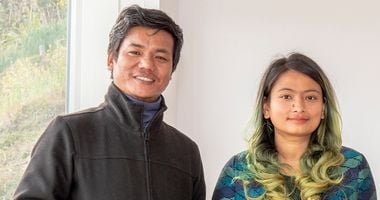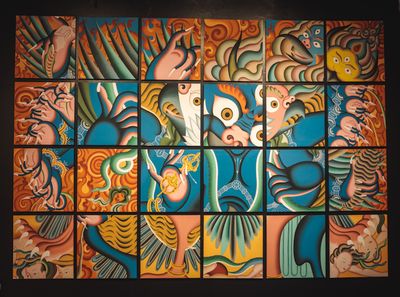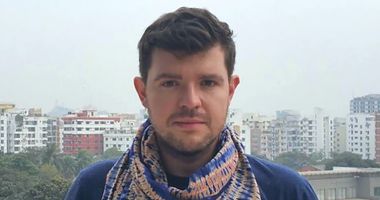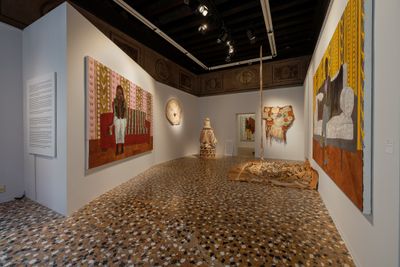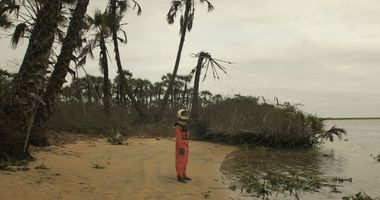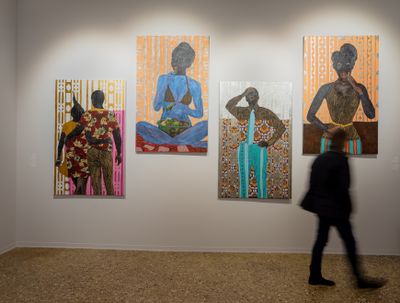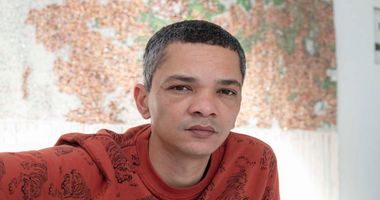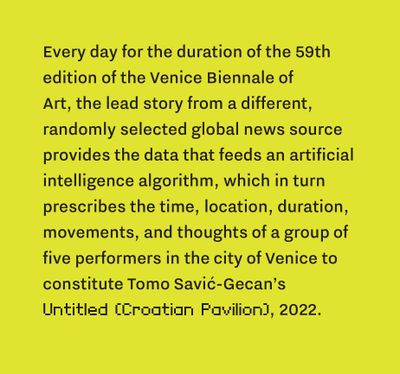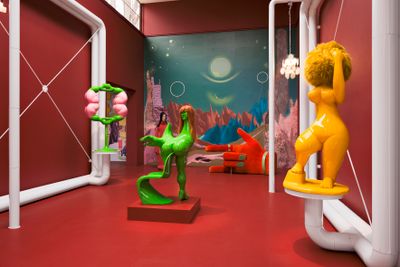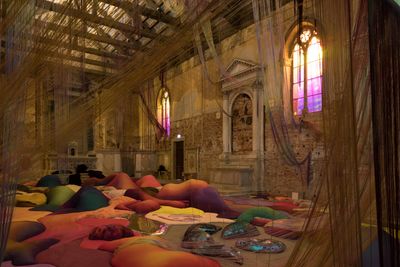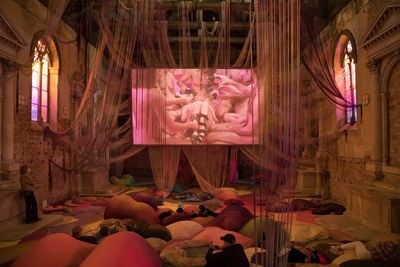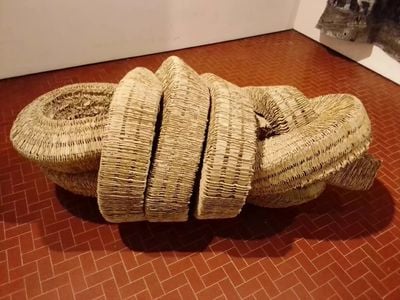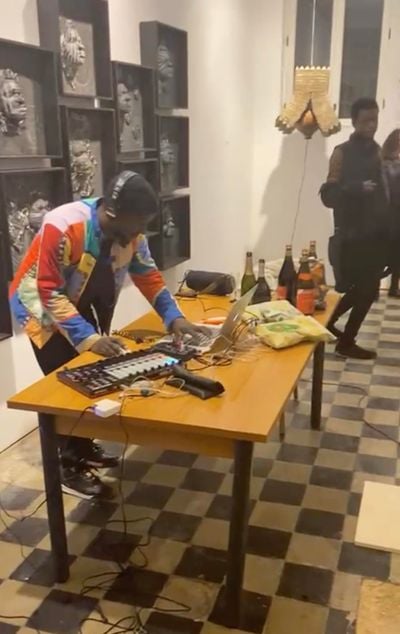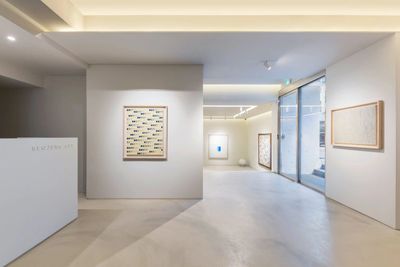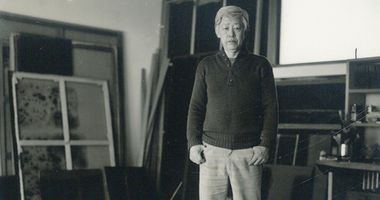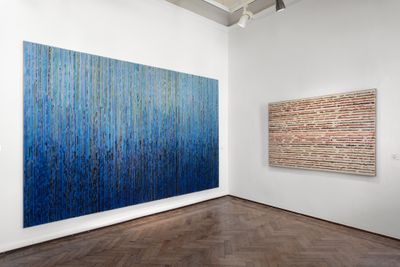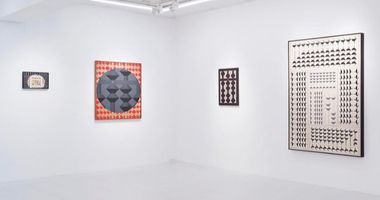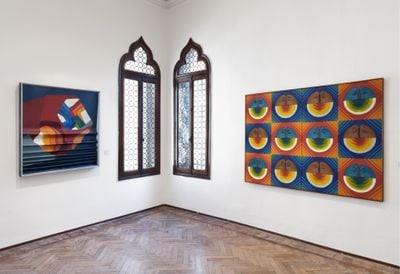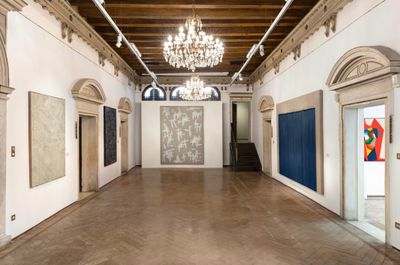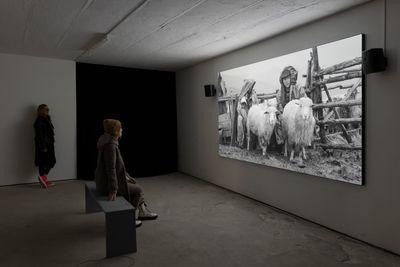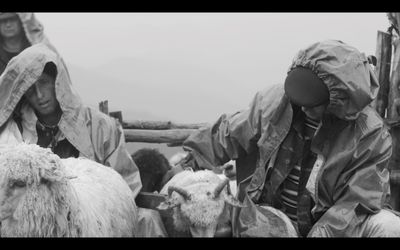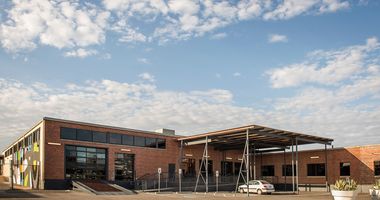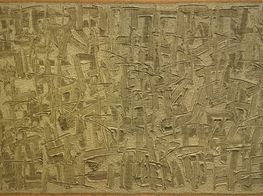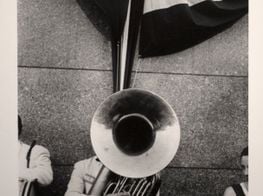Venice Biennale Highlights: Off-Site National Pavilions and Collateral Events
Following the pavilion highlights in the Giardini and Arsenale and reviews of parallel projects, Ocula Magazine visits a few collateral events and off-site national pavilions at the 59th Venice Biennale.

Tsherin Sherpa, 24 Views of Luxation (2022). Acrylic on canvas. 24 panels. 50.8 x 50.8 cm each. Made in collaboration with KarmaLama, Pasang Lama, and Phurba Hyolmo. Exhibition view: Nepal Pavilion, 59th Venice Biennale, The Milk of Dreams (23 April–27 November 2022). Courtesy the artist and Rossi & Rossi. Photo: Chhiring Dorje Gurung.
National Pavilions
Nepal Pavilion
Tsherin Sherpa, Tales of Muted Spirits
Sant'Anna Project Space One, Castello 994
The most striking thing about Tsherin Sherpa's painting 24 Views of Luxation (2022), whose title points to the disembodiment of its central figure, is its luminous, super-flat style that brings this stunning update of traditional Buddhist painting to life.
Consisting of 24 square panels arranged into rows of six by four, the work—produced in collaboration with Karma Lama, Pasang Lama, and Phurba Hyolmo—is a deconstructed vision of Garuda, who appears across Hindu and Buddhist myths; most often as the part-human, part-eagle vehicle of the god Vishnu, universal protector, and a guardian against ill fortune.
In Tibet, the figure of Garuda is enmeshed with the myth of the Himalayan bird of fire Khyung, known as a strong adversary against demons, becoming a god for both the Indigenous Bon tradition and the dominant Buddhist order.
In this composition, Garuda holds a snake, which refers to the semi-divine half-human half-serpent Naga, whom Garuda is said to have defeated in battle. (The saliva of eagles, incidentally, was apparently known as an antidote to snake bites.)
According to the curatorial text—pavilion curators Sheelasha Rajbhandari and Hit Man Gurung just closed a triumphant Kathmandu Triennale with Romanian Pavilion co-curator Cosmin Costinas—the form of the Garuda has been used in 'post-colonial Asian state configurations...to represent their own might as [national] protectors, but ironically this figure also underscores their role as persecutors'. The serpentine Naga, they pose, represents older animist beliefs in the region—Buddhism became an ideology of conquest, after all, just like the others.
With that, the delicate rendering of human forms that push to the very bottom edges of 24 Views of Luxation are telling presences made just-about-visible: the embodied cost of forceful, idealised images trained on power rather than people.
Uganda Pavilion
Radiance: They Dream In Time
Palazzo Palumbo Fossati, San Marco 2597
With sculptures by Acaye Kerunen and paintings by Collin Sekajugo, the Venice Biennale award jury's special mention to the Uganda Pavilion, curated by Shaheen Merali and beautifully installed at the Palazzo Palumbo Fossati, was deserved.
Sekajugo's paintings, made of barkcloth and acrylic, result in portraits like the 'Stock Image' series (2019–2022). In Stock Image 012 – Smiling Girl Eating Salad (2021), a woman sits cross-legged, her black bikini set off by the pastel blue strokes that cling from the neck down like sunscreen, with a salad between her legs, a leaf between her teeth, and a Mona Lisa smile.
If Sekajugo represents a stunning engagement with portraiture that utilises contextual materials to great effect—the barkcloth gilds each canvas to begin from another foundation while their titles link them into spheres of (digital, hence mechanical, historical) reproduction—Acaye Kerunen extends that material concern into conceptual abstraction.
Working with weaving artisans in Uganda, the artist creates natural woven-fibre installations and wall hangings that express the complexity of cultural forms and their connection to community, not only aesthetically, but through the making of the works.
Kerunen has described the wall hanging Banange (2021), for example, as a celebration of 'the different weaving styles and patterns from central Uganda'. It is a deconstruction of common, cultural items into a weave: bags forming rings in the work, or the mat and rope and their different colours, which the artist describes as 'very utilitarian in our culture'.
Formally, these works insist on the integrity of the materials themselves as art, as much as the craft—conceptually, they are portals not only into time and memory, but labour and skill.
Croatian Pavilion
Tomo Savić-Gecan, Untitled (Croatian Pavilion)
It's a hard sell (but economically efficient), not to have a pavilion when that is the very thing that guarantees the shiny visibility an event like this promises. So good on Croatian artist Tomo Savić-Gecan for putting a time-old critique where its mouth is and dispensing of the physical manifestation of nationalism altogether.
Working with Kunsthalle Basel's Elena Filipovic, Savić-Gecan decided to intervene in other pavilions, using their spaces as a stage from which performances play out according to a very particular formula that replicates something happening in the world at large: a shift to algorithmic power's call and response.
Each day, a lead news story randomly selected via artificial intelligence feeds an algorithm designed to determine the location, duration, choreography, frequency—and, per the statement, the 'prescribed thoughts'—of five performers. Taking place throughout the Venice Biennale, performers are given their briefs in the morning, including timings and venues.
On my visit, the day's selected news story was: 'Stop the "scam-demic". Amid rising number of cases, authorities urge to be more cautious' from The Star Malaysia. It was 2:58pm at the Austrian Pavilion, where Invitation of the Soft Machine and Her Angry Body Parts by Jakob Lena Knebl and Ashley Hans Scheirl is conceived as an open stage 'that invites the audience to explore the "spaces of desire"'.
A T.V. crew had already entered, and a young woman wearing a backpack and a wool hat asked, 'Is this Austria?' (I was wondering too.) Soon enough, she and a few others dressed like her started moving around, a camera circling them and us, a crowd accumulating, phones out. A muffled, shuffling pandemonium.
Dutch Pavilion
melanie bonajo, When the body says Yes
Chiesetta della Misericordia, Campo de l'Abazia, Cannaregio
Staged in the dramatically cavernous and ornate Chiesetta della Misericordia, a deconsecrated 13th-century church in Cannaregio, When the body says Yes (2022) by melanie bonajo is a monumental work that actually looks like its photograph.
This giant hall was treated as a whole, with filters, fabrics, and long, soft tassel curtains producing a rusty, peachy cream aura across the space, its floor covered in a quilt of pads and cushions—designed by bonajo in collaboration with scenographer Théo Demans—to create a kind of globular, three-dimensional floor painting. (Think Benglis drips, but pillow.)
Positioned at the back of the nave, covering where an upper gallery could have been, was a giant screen practically stretching from one side of the room to the other, reaching down from the ceiling, ending above our heads. Audiences were invited to take off their shoes, enter the room, and lie down—the floor design demands it.
I entered at the ideal time to experience the work, seeing bodies in the space, turning around, and sliding into place. Then looking up to a giant tableau of naked, oiled-up bodies in a clump, slipping on and over one another on a floor like ours. As we watch, we hear testimonies from people talking about their bodies, intimacy, and touch. It's a simple thing—enough to celebrate, really.
bonajo, no stranger to the video installation, has delivered a masterclass on how to create a Venice Biennale national pavilion exhibition sitting perfectly on the knife edge between sincerity and irony that it explodes into the realm of the sublime. Of course, the location deserves credit, too.
Vibe check: Zimbabwe
Santa Maria della Pietà, Sestiere Castello, 30122
The strong presence of African pavilions is one of the highlights of this year's Biennale. Among them, Kenya offers a beautiful show at Fàbrica 33 with artists Dickens Otieno, Syowia Kyambi, Kaloki Nyamai, and Wanja Kimani curated by Jimmy Ogonga.
Likewise, Cameroon's dramatic setting in the gorgeous (even by the standards of Venice) courtyard garden of the Liceo Artistico Guggenheim, features Jorge R. Pombo's uncanny and context-appropriate oil-on-linen self-rendition as *that* Salvator Mundi.

As for the pavilion celebrations during the preview, Zimbabwe, staging its sixth straight showing in Venice with 'I did not leave a sign?', a beautiful show curated by Fadzai Veronica Muchemwa and commissioned by National Gallery director Raphael Chikukwa, was a clear winner; followed by a close-second match made in heaven, Korean-Icelandic love-in, presided over by DJ High Future in the rain.
With an open-door policy and a closing time that went well beyond its 11pm mandate, Zimbabwe's was a celebration in every sense. A meeting of old and new friends, among them Dak'art's Simon Njami and Milk of Dreams artist Bronwyn Katz, hosted by the collective PUNGWE, which translates to 'night vigil'.
The party was described as a communion with the pavilion artists: Ronald Muchatuta, Kresiah Mukwazhi, Terrence Musekiwa, and Wallen Mapondera. The latter's egg-crate sculptures on view make masterful use of the material to create solid abstract forms that match the artist's adept manipulation of found materials, resulting in intricate works of minimalism.
The sound system was epic, manned by the stylings of Mo Laudi and Robert Machiri—vibes (and shazaam) all night.
Collateral Events
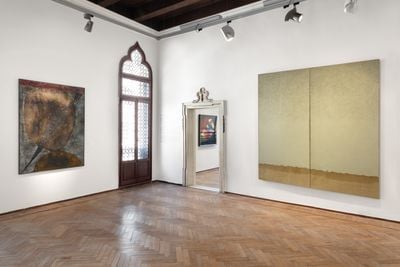
Ha Chong-Hyun
Palazzetto Tito, Dorsoduro, 2826
You always know when you see a Ha Chong-Hyun 'Conjunction', and it's always a pleasure to encounter one, as was the case with this exhibition organised by Kukje Art and Culture Foundation at Palazzetto Tito, home of the Istituzione Fondazione Bevilacqua La Masa.
A pivotal figure in the Korean avantgarde, Ha is known as a master of Dansaekhwa—Seojung Art are currently exhibiting Lee Ufan, Park Seo-Bo, Kim Tschang-Yeul, Yoon Hyung Geun, and Chung Sang-Hwa in a show about the movement.
He created his characteristic 'Conjunction' paintings by stretching hemp cloth and burlap sack—like those containing U.S.-sent relief goods during and after the Korean War—onto frames and pressing oil paint through the fabric's pores from behind: a unique form of gestural, minimalist painting that moves between monochromatic and geometric abstraction, which the artist has described as a commitment to the body.
Ha's most meditative conjunctions, like one navy triptych in this show, Conjunction 98- 203 (A) (B) (C) (1998), form blocks of oil paint on hemp cloth. As the artist stops pressing down on the pigment, the tip becomes a voluminous edge. Mesmerising, timeless, perhaps, because of their innovative origins, paintings like these seem to herald the practices of artists like Summer Wheat, worlds away, whose paintings similarly take advantage of a weave's grid.
But what makes this exhibition by this unequivocal master of minimalist painting such a delight, is how curator Sunjung Kim presented it as a concise capsule survey, offering an intimate glance into a storied artistic career, across five sections starting from 1967 to now.
Works from the 'Naissance' series (1967–1968) were a particular highlight, if intriguing, given how far Ha has come since then. Naissance 67 is an oil-on-collage canvas cross that creates a chessboard of geometric patterns using a basket weave and oil paint, and recalls the bold colour lines of paintings in Korean Buddhist temples.
Then, there's the psychedelic, geometric earthwork abstraction, Birth-B (1967)—a large horizontal canvas subdivided into 12 squares, four across by three, each an alternation of the same form in a colour range of navy, russet, and yellow: a circle, lower-half woven grid, upper-half two half mounds made from lining up string. (Bringing to mind the textured circles of Gutai contemporary, Yuko Nasaka.)
Another delight: the 'Post-Conjunction' series (2008–2012), a further example of how Ha has continued to evolve through his practice.
Rather than press from behind, this time Ha pressed from above and below, lining up canvas rows and pressing them together to form the 'surface', resulting in image planes that appear as micro-mountain regions as much as calligraphy on a page, like the blue-scale Post-Conjunction (2010).
ZINAIDA: Without Women
Spiazzi, Castello, 3865
23 April–27 November 2022
It's true, the PinchukArtCentre pivot from The Future Generation Art Prize @ Venice 2022 to This is Ukraine: Defending Freedom as their official collateral event was the right thing to do.
Presented in partnership with Ukraine's Ministry of Culture and Information Policy and the Office of the President of Ukraine—a message from Zelensky, 'We are defending our freedom,' is scrawled on the exhibition banners and he addressed the opening by video—this is a very big exhibition in every sense.
At the very back of the second-floor space, a monumental tarp by JR hangs from ceiling to floor; a black-and-white photograph of a smiling, five-year-old Valeriia, one of over four million Ukrainian children forced into displacement. The tarp was used in Lviv when JR and 100 city residents marched outside the National Opera to protest the deliberate Russian bombing of the Mariupol Drama Theater.
Then, there is Nikita Kadan's Difficulties of Profanation (2015–2022), which gathers objects—rubble, bits, and iron—from Donbas in 2015, and Kyiv and Kharkiv in 2022, the second iteration of the work after it was first shown at the Ukrainian National pavilion in 2015; and Yevgenia Belorusets' The war diary February-April, 2022. Kyiv (2022), which the artist started on the first day of invasion, writing every day until 10 April.
Ukrainian artist ZINAIDA's exhibition Without Women, presented by The Visual Research Support Foundation and curated by Dallas Contemporary Executive Director Peter Doroshenko, is quieter. But its impact is just as great.
Staged in the premises of art space Spiazzi, at a beautiful point on the canals where a bridge cuts over from the corner of a small building on a narrow path, three black-and-white films from 2017 have been installed.
Filming in the Carpathian mountains, the artist zooms in on the work of traditional sheep herders with a view that brings to mind, among other things, the textures of Robert Frank's The Americans, the sublimated drama of Pasolini's Gospel According to St. Matthew, and the pace and patience of Tarkovsky's Andrey Rublev.
Each film is unassuming, monastic—shot in a cinematic black and white with a palpable verité perspective. The focus is on the intricacies of the labour at hand, from shearing sheep to churning cheese, the latter a portrayal so epic and beautiful that it brought to mind Goya's The Forge. —[O]





